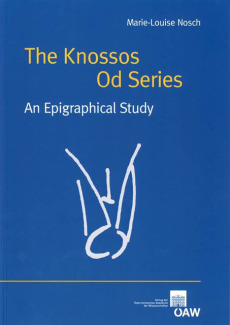Marie L Nosch
The Knossos Od Series
An Epigraphical Study
Reihe herausgegeben von Sigrid Deger-Jalkotzy
Reihe: Denkschriften der philosophisch-historischen Klasse, Mykenische Studien, Veröffentlichungen der mykenischen KommissionDiese Studie ist eine epigraphische Untersuchung der Linear B-Täfelchen aus dem Westflügel des Palastes von Knossos. Im Fokus sind die 61 unklassifizierten Od-Täfelchen mit dem Ideogramm für Wolle. Die Autorin präsentiert eine neue Klassifikation der Od-Täfelchen, indem sie entweder neue Sets identifiziert oder unklassifizierte Od-Täfelchen in vorhandene Od Sets oder in andere Serien, wie die bekannten und wohl recherchierten „Büros“ für Textiladministration und Schafhaltung, integriert. Die jüngste Erforschung der Fundplätze von FIRTH hat in diesem Bereich neue Informationen ergeben. Im Ganzen werden 29 Präfix-Änderungen präsentiert. Nur wenige unklassifizierte Od-Täfelchen können mit den Textil-Schreibern 103 und 113, die Produktions-Solls und anfängliche Prozesse der Textilproduktion verwalten, in Verbindung gebracht werden; im Gegenteil gehören viele unklassifizierte Od-Täfelchen zum Schlussprozess der Textilproduktion wie Fertigstellung und Dekoration. Darüber hinaus wird der unlängst von KILLEN und MELENA identifizierte Schreiber 227 präsentiert. Schreiber 227 registriert kleine Mengen Wolle; Die Schrift des Schreibers 227 gleicht der Schrift der Schreiber 113 und 115, und der Fundort ist I1, in der Nähe des Nordeingangs. Insofern unterscheidet sich seine Aufgabe von der des bekannten Schreibers 103. Damit hat sich die ausgeprägte Spezialisierung und Aufgabenteilung im Palast von Knossos erneut bestätigt.
…
This study is an epigraphical investigation of the Linear B records from the West Wing in the palace of Knossos. Its focus is the group of 61 unclassified Od tablets with the ideogram for wool. The author presents a new classification of the Od tablets by identifying new sets, and by integrating unclassified Od tablets into existing Od sets or into other series recording wool, such as the two well known and thoroughly researched “bureaux”, the textile and the sheep administration. Recent work by FIRTH on find-places has provided new insights for this study. In the present study, 29 prefix changes are suggested. Only few unclassified Od tablets, however, can be associated with the initial parts of textile production in which scribes 103 and 113 set targets and manage the production. Rather, many unclassified Od tablets belong to the final stages of the textile production, that is, the finishing and decoration of the cloth. Moreover, scribe 227, newly identified by KILLEN and MELENA, is presented. Scribe 227 records small amounts of wool, writes in a style similar to the writing of scribes 113 and 115, and is associated with the area I1 near the North Entrance. His administrative practices thus seem distinct from the better known practices of scribe 103. This confirms the high degree of specialisation in the palatial administration at Knossos.

